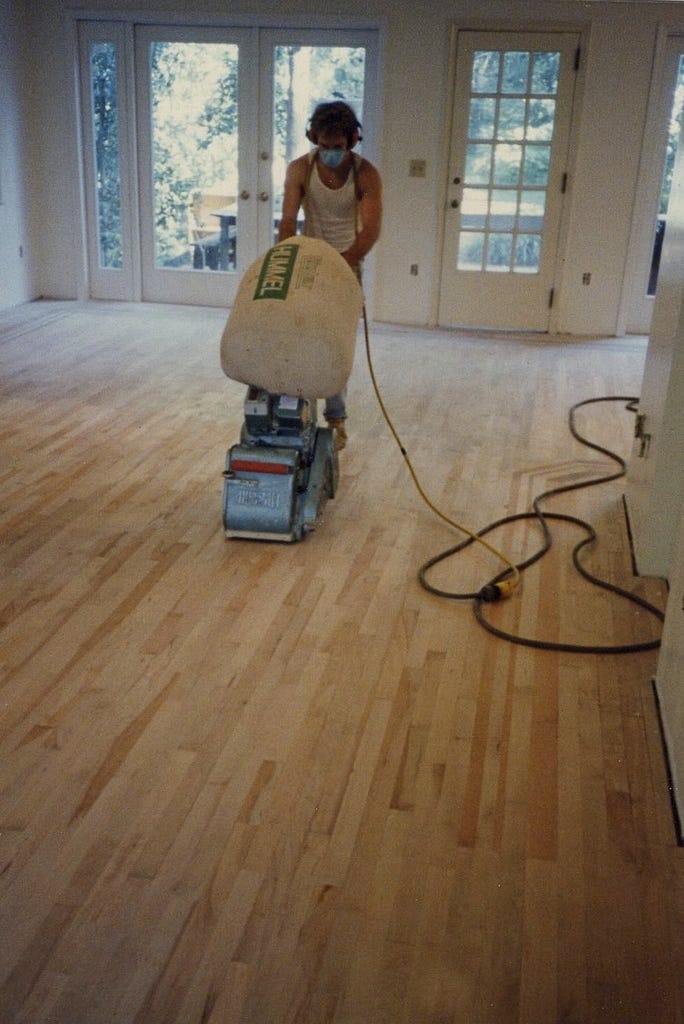
The only way I have ever decided to take on truly colossal projects is through total ignorance and lack of imagination about what would be involved. The irony is that if I had had a better imagination and truer judgment, I would have been much less productive in several areas of my life. This includes several massive field experiments, writing a 734-page book, another 230-page book, building a palapa in the back yard and "developing" The Propiddy in Arizona. The one thing I haven't yet been stupid enough to undertake is to build a house, but I skirted pretty close by deciding to put a wood floor into the house we bought in 1989. The floors were polished concrete, but we wanted wood, and being the scrounge that I am, not just any wood, but salvaged wood, preferably heart pine from the virgin longleaf pine forest. I mean, how hard could it be, right?
Having bought salvaged heart pine lumber from L.D. Hitson a couple of years previously, I called to see if he had some available. Sure, he said, come on over to Quincy to the Dixie Leaf Tobacco Co. warehouse.
As we chatted standing on the dirty, blackened floor in one of the large, remaining rooms of the warehouse, I said, What’s this floor made of? I don't know, he said. So, I scraped a few square centimeters, and said, It's maple. How much you want for it? Fifty cents a board foot if you pull it up, a dollar if I pull it up. I said, I'll pull it up.
It was a fateful moment.
Pulling up tongue and groove maple flooring is tricky, for the edges of the wood are easy to split while prying the boards off the subfloor. Armed with jimmies and hammers, I spent many days removing the maple boards, almost 2000 square feet, one by one, pulling out the old-fashioned square nails. It was fun, and the breaks were filled with jokes and banter with L.D. and his helper, with me as the honorary country boy. My adolescence in Alabama finally paid off.

In two or three weeks, I had a huge mound of 2 1/4 -inch maple flooring, along with a couple of dozen 2 x 10 heart pine floor joists. Delivered to my driveway in L.D.'s dump truck, it made a pile taller than me.
After stacking it in my garage, I ran each board through my portable Ryobi planer, scraped the bottoms clean of tar paper, making my arms ache and costing me, a year later, rotator cuff surgery. Next, I sawed each 2 x 10 joist into four 1 x 5s, planed them to 3/4 inch and milled the edges into tongues & grooves using a borrowed router. The noise was constant, shavings half-filled my garage, and the turpentine smell of pine was exhilarating.

You can't nail a wood floor directly into concrete but must first glue a plywood subfloor to the concrete and shoot it down with concrete nails fired from a 22-caliber pistol. Because the concrete was over 40 years old, it had reached maximum hardness, requiring the maximum powder load in the 22-caliber cartridges. After 1500 square feet of plywood, buckets of mastic and 500 shots from the pistol, my shootin' hand had swelled to twice its normal size, and even wearing thick gloves, I winced every time I pulled the trigger.

With the plywood down, I rented a flooring nailer, a device that you whack with a big rubber mallet, and it drives a special nail at just the right angle through the edge of the board and into the plywood. Of course, a plain, straight floor wasn’t good enough for me, so I installed a decorative border of maple and cherry all around the perimeter of the room. Fitting this border around corners made me grateful to my high school trigonometry teacher. Then I started laying the main floor at one decorative perimeter edge, and by the time my installation approached the opposite wall, I understood that walls in real houses are never actually parallel. As cooks cover errors with whipped cream, flooring errors can be covered with baseboards and shoe molding. I laid the hall floor in a herringbone pattern, also with a decorative edge. The heart pine floors in the guest room, my study and Vicki’s study went down a lot faster because I cut the boards from three to five inches wide. Fewer boards, fewer nails. With the final installation of these heart pine floors, the job was complete, and ready for sanding.

Floor sanding takes a big machine and a high level of skill, and considering the amount of work I had put into these floors, I wasn’t going to risk doing it myself, so I hired a pro. After sanding, we had the floor finished with a special Swedish varnish that made our eyes water and forced us to spend two nights in a motel as the house aired out. With all the windows wide open, you could smell this stuff from a half block away. How Swedes survive this stuff is a mystery, but maybe that is why their population doesn't seem to increase.

Looking back, the pride and satisfaction I get from seeing those maple and heart pine floors would never have happened if my imagination and judgment had been better. Sometimes the response, “how hard could it be?” is just the right response.







Tenacious
Scrounge
Clever
Heroic
Ingenious
Noble
Know-how
Endurance
Limitless
A beautiful end result! Your designs remind me of this house in NY which took the wood paneling quite a bit further than most. The owners used a mix of oak, ash, and redwood if I'm not mistaken. https://www.realtor.com/realestateandhomes-detail/22-Sarah-Ln_Hopewell-Junction_NY_12533_M36389-61642